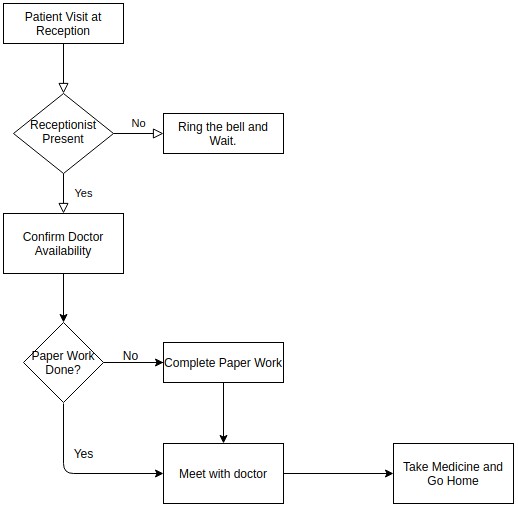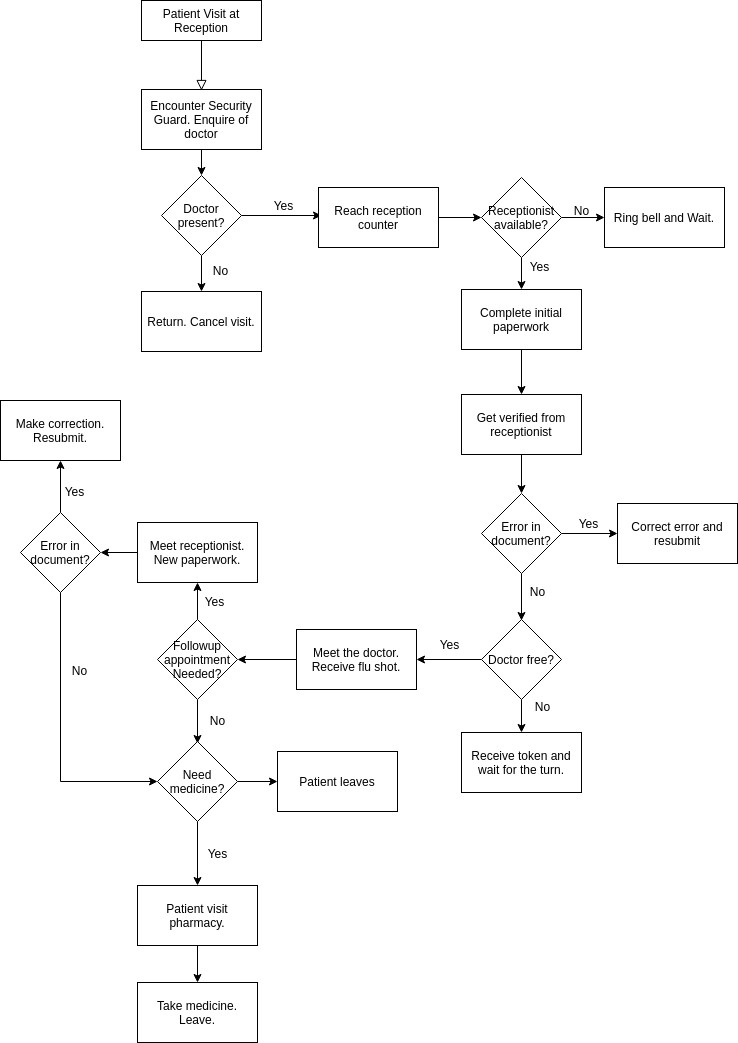Business Operation Improvement
Question :
Your primary care physician operates a sound business practice that, at times, seems to suffer from several forms of waste. In your role as a dedicated patient engaged in the study of operations management, you are in a unique position to offer an analysis of your doctor’s business operation to recommend improvements.
Consider the common interpretation of service processes in use at many organizations, which is used to identify four variants of a service process:
The process that is formally defined and recorded in a business document.
The process that everyone generally believes exists.
The process as it actually exists.
The process that should exist to deliver what the customer really wants.
Using your arrival at the doctor’s office as a starting point in the process, create a document that focuses on the process of visiting your doctor for a flu shot. Be sure your document incorporates the following:
The introduction describes what you intend to do and how you will approach the task.
A simple flowchart that maps the sequence of operations for variant #1 and/or #2 above. While you may need to make certain assumptions in your description of variants #1 and #2, your process map should include, at a minimum, all components of the process that are visible to the patient. You may choose to combine your analysis of the first two variants due to lack of information on either one.
A flowchart that maps the process that actually exists (variant #3).
A flowchart that maps the process according to variant #4, as you believe it should be.
Above each flowchart, include a paragraph describing the key process components and identify potential problems or elements of waste in the process map that follows.
From the list of successful techniques for eliminating waste in service companies in this week’s readings, select three that you feel are appropriate in shaping your recommendations for improvement in the doctor’s service process. For each of the three techniques, briefly describe what would need to occur.
Answer :
Introduction
The purpose of this paper is to provide analysis of the business operation of the doctor’s clinic and also recommend improvements to it. The process taken into consideration is taking the flu shot by the author. The approach will be to first understand the process that is documented or what everyone believes is there at the clinic. After that, the next step will be to understand the actual process that is in existence at the clinic. And the next step will be to build a process that should be in place to ensure that the customers feel satisfied at the clinic. Further, recommendations are given for successful techniques that the doctor should adopt for improvements.
Documented or believed operation sequence (variant #1 or #2)
The clinic does not have any documented process for conducting operational activity. But there is a general understanding among everyone regarding the overall process that exists at the clinic. The process is shown in diagram 1. It can be seen that the process is quite simple with almost no hurdle. It seems like a bird’s eye view of the entire process that is supposed to run smoothly. The issue with this understood process is that it is too vague to picturise all the technical details that take place in the clinic once a patient arrives. It shows the lack of understanding among the staff about what is actually happening around. Diagram in the next section shows the disconnection between the actual and believed.

Diagram 1: Generally believed process existing at the clinic
Process that actually exist (variant #3)
In the diagram 2 below the actual process that exists at the clinic has been shown. In actuality, there are various processes that are being conducted at the clinic from the moment a patient arrives and the moment he or she leaves. It can be seen that there are several instances of overprocessing that is going on here. One case of overprocessing is during paperwork (De Lepeleire et al, 2016). It is also time consuming. In the digital age, this seems like unnecessary activity. Another issue is that patients also end up leaving the clinic if the doctor is unavailable. Security guard is an additional barrier, throttling the process efficiency.

Process it should be (variant #4)
In the diagram 3 below, the process that should be implemented at the clinic has been presented. In the process it can be seen that the benefit of technology has been leveraged. This has helped in significantly shortening the time consumed in various paperwork activities. Moreover, patients are not required to inquire if the doctor is available. They can do it online using a desktop or smartphone.
Successful techniques for eliminating wastes
Given below are the three techniques that can be adopted at the clinic that can help in reduction of wastes:
Improving quality: Improvement in work quality will ensure that the customers are satisfied. Customers expect quality in exchange for the money they pay to the clinic. Therefore, looking at the service areas that can be improved and improving those areas will greatly help (Miwa & Watanabe, 2020).
Optimum processing: Overprocessing often leads to waste of time and resources. It is when additional activity or resources are being implemented to get things done (Anisi et al, 2017). Unnecessary paperwork is one example.
Reducing lead time: Time gap between process steps can be reduced to ensure functioning. This method ensures that the time is saved during the whole process, which in turn will help in handling more patients (Wong et al, 2016).
Recommended changes
Three recommended changes for the clinic are as below:
1. The clinic should implement a website with an online appointment facility. This can be implemented within two to three months time frame. This will hugely help customers in making online appointments and thus saving everyone’s time whether it is customers, the receptionist, or the doctor.
2. Second recommendation is the online display of the available schedule of the doctor. This will ensure that the patients do not have to wait when they come at the clinic, or they do not have to return due to doctor’s unavailability. This can be implemented on the website in a few weeks’ time. And it will help in improved management of time for customers and the doctor. Further, it will also reduce chaos.
3. Next recommendation is to conduct periodic process audits to identify loopholes and eliminate them. It can take around a week to be done and will help in continued improvement (Thangaraj & Chacko, 2018).
Conclusion
Overall it can be said that the improvement of the process at the clinic is required as there are several activities that are time consuming and waste of the clinic's resources. The suggested changes can help improve the current operational situation.
References
Anisi, S., Marzban, S., Zarei, E., & Sepehri, M. M. (2017). Identifying Process Improvement Opportunities in Gynecology Clinic by Value Stream Mapping. Institute of Integrative Omics and Applied Biotechnology Journal, 8(1), p27-32.
De Lepeleire, J., Monstrey, M., Pierloot, S., & Vanthomme, S. (2016). Application process for nursing homes: Towards a standardized admission form. Tijdschrift voor Geneeskunde, 72(17), 973-980.
Miwa, H., & Watanabe, K. (2020). Toward Service Process Improvement in Nursing-Care Services. In International Conference on Serviceology (pp. 253-265). Springer, Singapore.
Thangaraj, P., & Chacko, T. V. (2018). Process audit on quality of out-patient records using WHO chart audit as a tool for training interns and improving quality of service delivery in an urban health training centre. Journal of Education Technology in Health Sciences, 5(1), 15-19.
Wong, A. M., During, D., Hartman, M., Lappan-Gracon, S., Hicks, M., & Bajwa, S. (2016). Lean Transformation of the Eye Clinic at The Hospital for Sick Children: Challenging an Implicit Mental Model and Lessons Learned. Healthcare quarterly (Toronto, Ont.), 19(1), 36-41.









